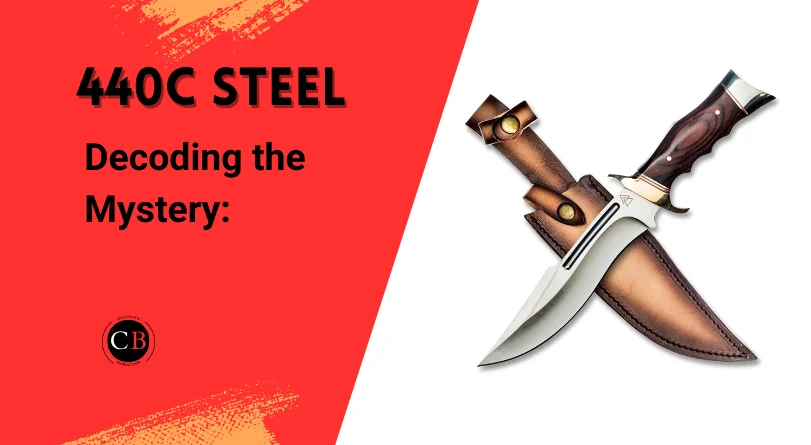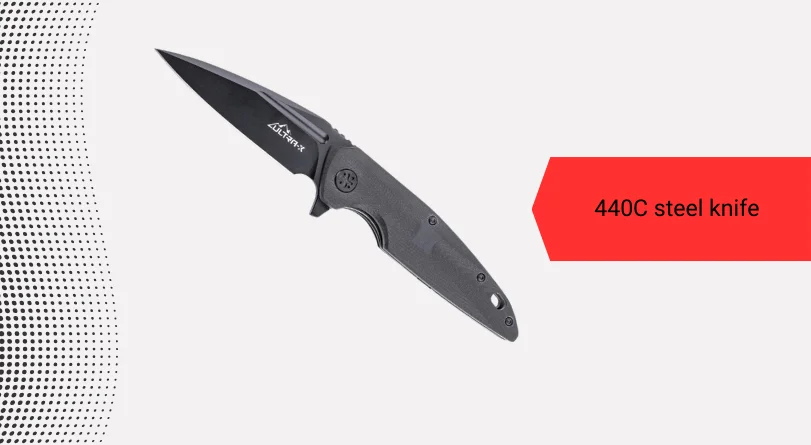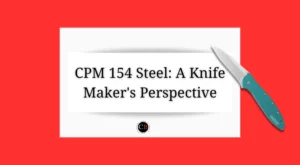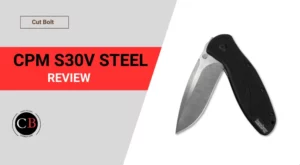Forget diamonds, 440C steel is the real hidden treasure! This legendary blade material promises razor-sharp edges that last, a toughness that laughs at abuse, and all without rusting at the first sniff of moisture.
But is 440C steel good for knives? Or just a glistening mirage in the desert of dull blades? Sharpen your focus, folks, because we’re about to dissect 440C and see if it deserves a place in your pocket (or strapped to your thigh). Remember, this steel has gained a lot of popularity in the last 20 years thanks to some legendary knives, for example, the BUCK 110.
Get ready for a high-octane dive into the world of blade-worthy steel!
Table of Contents
What is 440C steel?
440C is a martensitic stainless steel and part of the 440 series (440A, 440B and 440C) – high carbon stainless steels (440C has more than 1%, which is the highest carbon content of the 440 series), it offers excellent wear resistance and corrosion resistance and is used in budget and mid-range knives.
440 steel is a group of steels (440A, 440B and 440C) with similar but sometimes quite different properties. It is very important to understand that the various 440 steels do differ noticeably. 440A and 440B are “softer” grades. While these are extremely resistant to rust and can be polished to a great mirror finish, their edge retention is not as good as 440C steel (data sheet: here).

Is your knife made of 440C steel or not?
Softer steels are used in the industrial production of knives in factories, as the blades are stamped out of sheet steel using dies. 440C steel is too hard and expensive for this process. Many manufacturers are intentionally non-specific about what steel they use.
If the blade is labeled “stainless steel,” “surgical stainless steel,” or just “440 stainless steel,” you can bet it’s not 440C. That’s because 440C is a much better and more expensive steel, and if a blade is made of 440C, it will usually be labeled “440C” as a selling point.
This is so far one of the main differences between mass-produced knives and (individually) handmade knives. Factories have to use the softer steels for the stamping process. A knifemaker making custom knives doesn’t have that restriction, so they will almost always use the better knife steel.
So when someone says that 440 stainless steel (or any stainless steel) is not holding the edge, they are most likely comparing it to a factory knife with a lower grade 440 stainless steel. The fact is, there are several excellent stainless steels out there, that hold their edges, provided they are properly processed and heat treated.
440C steel chemical composition
440C consists of the following alloying elements:
| Element | Portion | Effect |
| Chrome | 16 – 18.0% | Improves wear resistance, heat resistance and scale resistance. It increases tensile strength because it acts as a carbide former. Use of rust-proof or stainless steel, as it increases corrosion resistance from a mass proportion of 12.2%. Reduction in weldability. |
| Carbon | 0.95 – 1.20% | Increasing hardness and tensile strength. In larger quantities, increase in brittleness and reduction in forgeability and weldability. |
| Manganese | 1.00% | Improves hardness and tensile strength. |
| Molybdenum | 0.75% | Improves hardenability, tensile strength and weldability. Reduction in forgeability and ductility. |
| Phosphor | 0.04% | Increases tensile strength, hardness and corrosion resistance but also brittleness. |
| Sulfur | 0.03% | Increases machinability but also brittleness. |
| Silicon | 1.0% | Improves strength. |
Carbon is used to increase hardenability and wear resistance but reduces toughness in larger quantities. Manganese is added to reduce brittleness and improve forgeability, hardenability and deformation. Silicon is a deoxidizer and improves hot workability. Chromium added in high amounts only to high alloy tool steels improves hardenability, high wear resistance, toughness and corrosion resistance. Molybdenum improves deep hardening and toughness as well as wear resistance.
These basic elements, along with iron, are a simple combination that works well and has been used for many decades.
Remember, the perfect steel depends on your specific needs and preferences. Explore, experiment, and find the one that speaks to your inner blademaster!
440C knife steel hardness
440C stainless steel typically has a hardness ranging from approximately 58 HRC (Rockwell Hardness Scale) to 60 HRC when properly heat-treated. The hardness level can vary based on the specific heat treatment process used by the manufacturer.

Keep in mind that hardness is just one of several factors that contribute to the overall performance of a blade, and other properties such as corrosion resistance, toughness, and wear resistance are also important considerations in evaluating a steel’s suitability for a particular application.
Is 440C a stainless steel?
Yes, 440C is a stainless steel. 440C steel is one of the hardest stainless steels and through heat treatment can achieve the highest strength, hardness and abrasion resistance of all stainless steels. This is due to its very high carbon content (C=carbon), which makes it suitable for applications such as knives, ball bearings and valve parts.
The chemical composition of 440C steel is a combination of high chromium (17%) and high carbon (more than 1%), resulting in a stainless steel with high abrasion and corrosion resistance.
440 steel – 440A, 440B, and 440C compared
You’ve seen these designations on knives for decades, yet they are more a source of confusion than information. It’s time to clarify a few things.
First, there is NO such thing as “440” steel.
There is no meaning without the letter, Imagine someone mentioning they drive a “Ford 200.” Without specifying the model (like Mustang, Focus, or Explorer), it’s impossible to gauge the performance, features, or overall quality of the vehicle. In the same way, simply saying “440” steel without the accompanying letter (A, B, or C) is like providing only the first part of the information, leaving a significant gap in understanding the specific characteristics and attributes of the steel.
Therefore, here is a brief outline of the main characteristics and differences between the various “440” steels:
440A steel
440A is a hardenable stainless steel alloy that can be hardened to a higher hardness than 420 series stainless steel (which can only be hardened to 52 HRC!). It has good corrosion resistance and is used in lower-cost bearings and harder surgical tools (rather rarely). It has a carbon content of 0.6 to 0.75%, about the same as most steel springs. Its advantage is that it is cheaper than 440B and somewhat more corrosion-resistant.

440B steel
440B is also a hardenable stainless steel alloy, which can be hardened to a higher hardness than 440A. It has good corrosion resistance and is used in standard cutlery, valves and instrument bearings where high corrosion resistance is more important than low wear. 440B contains 0.75 to 0.95% carbon.
440C steel
440C is also a hardenable stainless steel alloy that can be hardened to a higher hardness than 440B. It has good corrosion resistance and is used in ball bearings and races, high-pressure nozzles, valve seats and high-wear components. 440C contains 0.95 to 1.20% carbon. In the textbook, it would be described something like, “This steel has the highest quench hardness and wear resistance of any corrosion heat resistant steel when heat treated.”
All three steels have the same chromium content of approx. 16 to 18%. They are all high chromium martensitic stainless steels. All other alloying elements are about the same, including manganese, silicon, phosphorus, sulfur and molybdenum. Truly, the difference between these three steels is the carbon content. And it is significant because the higher carbon content in 440C steel results in a much more wear-resistant knife blade.
My Opinion: Is 440C steel good for knives?
440C steel is a popular choice for knifemakers, but navigating its strengths and quirks requires some exploration. Let’s dive into the world of 440C to see if it’s the perfect fit for your next blade:
- Sharpness & Edge Retention: 440C boasts impressive hardness, leading to razor-sharp edges that retain their bite for extended periods. Imagine slicing through juicy fruits and tough cuts with the same effortless glide!
- Durability & Toughness: This steel stands up to wear and tear like a champ. Whether you’re tackling the wilderness or the kitchen counter, 440C can handle bumps, scrapes, and even accidental drops with admirable resilience.
- Corrosion Resistance: While not completely immune to rust, 440C offers decent protection compared to other high-performance steels. Proper care and maintenance will keep your blade looking its best, even after facing the elements.
- Sharpening Challenge: The high hardness of 440C comes with a trade-off – sharpening can be a bit more demanding. You’ll need the right tools and techniques to bring back that razor-sharp edge.
- Price & Availability: Compared to some exotic steels, 440C is readily available and budget-friendly. This makes it a great choice for both seasoned knifemakers and those starting their journey.
The Verdict: Why you should get a knife made of 440C steel
440C steel is a versatile option for various knife styles, from everyday carry folders to robust outdoor blades. Its impressive sharpness, durability, and affordability make it a popular choice for both professionals and enthusiasts. However, keep in mind the sharpening challenge and invest in the right tools and techniques to maintain its edge.
Final words: Is 440C a good knife steel?
Collectors, enthusiasts, military professionals, and experts in various fields, among others, will keep buying custom-made 440C steel knives. Why? Because 440C is excellent for hand knives! It’s bright, looks good, durable, and proven—given proper processing and finishing. 440C excels in corrosion resistance and is significantly stronger than carbon steels at a reasonable price.
It boasts high wear resistance, toughness, and exceptional utility value in surface finish—a crucial but often overlooked aspect. The military-industrial complex and the machine tool industry won’t be replacing this high-quality martensitic stainless steel anytime soon. Currently, there’s no equivalent replacement for 440C. If a cheaper alternative with the same properties existed, it would have emerged long ago.
In terms of appearance, there are very few steels that can match 440C in terms of toughness and wear resistance. A polished 440C steel blade will hold its finish for many decades with a minimum of maintenance. 440C steel is reasonable to sharpen, it is inexpensive, and it can be machined with reasonable effort. That’s why it’s simply a popular knife steel and is likely to remain so for a long time to come.



